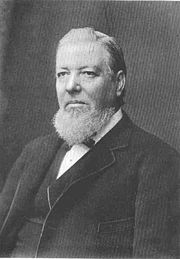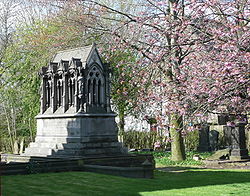
Richard Peacock
Encyclopedia

England
England is a country that is part of the United Kingdom. It shares land borders with Scotland to the north and Wales to the west; the Irish Sea is to the north west, the Celtic Sea to the south west, with the North Sea to the east and the English Channel to the south separating it from continental...
engineer
Engineer
An engineer is a professional practitioner of engineering, concerned with applying scientific knowledge, mathematics and ingenuity to develop solutions for technical problems. Engineers design materials, structures, machines and systems while considering the limitations imposed by practicality,...
, one of the founders of locomotive
Locomotive
A locomotive is a railway vehicle that provides the motive power for a train. The word originates from the Latin loco – "from a place", ablative of locus, "place" + Medieval Latin motivus, "causing motion", and is a shortened form of the term locomotive engine, first used in the early 19th...
manufacturer
Manufacturing
Manufacturing is the use of machines, tools and labor to produce goods for use or sale. The term may refer to a range of human activity, from handicraft to high tech, but is most commonly applied to industrial production, in which raw materials are transformed into finished goods on a large scale...
Beyer-Peacock
Beyer-Peacock
Beyer, Peacock and Company was an English railway Locomotive manufacturer with a factory in Gorton, Manchester. Founded by Charles Beyer and Richard Peacock, it traded from 1854 until 1966...
.
Early life and education
Born in SwaledaleSwaledale
Swaledale is one of the northernmost dales in the Yorkshire Dales National Park in northern England. It is the dale of the River Swale on the east side of the Pennines in North Yorkshire.-Geographical overview:...
, Richard Peacock was educated at Leeds Grammar School
Leeds Grammar School
Leeds Grammar School was an independent school in Leeds established in 1552. In August 2005 it merged with Leeds Girls' High School to form The Grammar School at Leeds. The two schools physically united in September 2008....
but at 14 left to be apprenticed at Fenton, Murray and Jackson
Fenton, Murray and Jackson
Fenton, Murray and Jackson was an engineering company at the Round Foundry off Water Lane in Holbeck, Leeds, West Yorkshire, England.-Fenton, Murray and Wood:...
in Leeds
Leeds
Leeds is a city and metropolitan borough in West Yorkshire, England. In 2001 Leeds' main urban subdivision had a population of 443,247, while the entire city has a population of 798,800 , making it the 30th-most populous city in the European Union.Leeds is the cultural, financial and commercial...
.
Career
At 18 Peacock was a precocious locomotive superintendent on the Leeds and Selby RailwayLeeds and Selby Railway
The Leeds and Selby Railway was an early British railway company and first mainline railway in Yorkshire. It was opened in 1834.The company was absorbed by the York and North Midland Railway and the line remained in use through the subsequent NER, LNER, BR and post-privatisation periods.As of 2010...
. When the line was acquired
Mergers and acquisitions
Mergers and acquisitions refers to the aspect of corporate strategy, corporate finance and management dealing with the buying, selling, dividing and combining of different companies and similar entities that can help an enterprise grow rapidly in its sector or location of origin, or a new field or...
by the York and North Midland Railway
North Eastern Railway (UK)
The North Eastern Railway , was an English railway company. It was incorporated in 1854, when four existing companies were combined, and was absorbed into the London and North Eastern Railway at the Grouping in 1923...
in 1840 he worked under Daniel Gooch
Daniel Gooch
Sir Daniel Gooch, 1st Baronet was an English railway and transatlantic cable engineer and Conservative politician who sat in the House of Commons from 1865 to 1885...
at Swindon
Swindon
Swindon is a large town within the borough of Swindon and ceremonial county of Wiltshire, in South West England. It is midway between Bristol, west and Reading, east. London is east...
, but reputedly fled to escape Gooch's wrath. In 1841, he became the locomotive superintendent of the Sheffield, Ashton-under-Lyne and Manchester Railway
Sheffield, Ashton-Under-Lyne and Manchester Railway
The Sheffield, Ashton-under-Lyne and Manchester Railway was an early British railway company which opened in stages between 1841 and 1845 between Sheffield and Manchester via Ashton-under-Lyne...
, subsequently the Manchester, Sheffield and Lincolnshire Railway
Manchester, Sheffield and Lincolnshire Railway
The Manchester, Sheffield and Lincolnshire Railway was formed by amalgamation in 1847. The MS&LR changed its name to the Great Central Railway in 1897 in anticipation of the opening in 1899 of its London Extension.-Origin:...
. In this role he was responsible for founding the Gorton locomotive works
Gorton locomotive works
Gorton Locomotive Works, known locally as Gorton Tank was located in Openshaw near Manchester, England and was completed in 1848 by the Sheffield, Ashton-under-Lyne and Manchester Railway.- History :...
for this railway, although he had left the firm shortly before they were completed in 1848.
In 1847 Peacock was present with Charles Beyer
Charles Beyer
Charles Frederick Beyer was a German-British locomotive engineer, co-founder of the firm Beyer-Peacock.-Early life:...
at a meeting at Lickey Incline which it is generally acknowledged gave birth to the Institution of Mechanical Engineers
Institution of Mechanical Engineers
The Institution of Mechanical Engineers is the British engineering society based in central London, representing mechanical engineering. It is licensed by the Engineering Council UK to assess candidates for inclusion on ECUK's Register of professional Engineers...
. George Stephenson
George Stephenson
George Stephenson was an English civil engineer and mechanical engineer who built the first public railway line in the world to use steam locomotives...
was elected as first president and Charles Beyer as a vice president. Peacock became a member of the Institution of Civil Engineers
Institution of Civil Engineers
Founded on 2 January 1818, the Institution of Civil Engineers is an independent professional association, based in central London, representing civil engineering. Like its early membership, the majority of its current members are British engineers, but it also has members in more than 150...
in 1849 .
In 1853, he joined Charles Beyer
Charles Beyer
Charles Frederick Beyer was a German-British locomotive engineer, co-founder of the firm Beyer-Peacock.-Early life:...
to found the celebrated locomotive company Beyer-Peacock
Beyer-Peacock
Beyer, Peacock and Company was an English railway Locomotive manufacturer with a factory in Gorton, Manchester. Founded by Charles Beyer and Richard Peacock, it traded from 1854 until 1966...
. Peacock had originally met Beyer through the acquisition of locomotives from Sharp Brothers
Sharp, Roberts and Company
Sharp, Stewart and Company was a steam locomotive manufacturer, initially based in Manchester, England. The company was formed in 1843 upon the demise of Sharp, Roberts & Co. and moved to Glasgow, Scotland in 1888, eventually amalgamating with two other Glasgow-based locomotive manufacturers to...
, and as mentioned earlier through both being among the founders of the Institution of Mechanical Engineers
Institution of Mechanical Engineers
The Institution of Mechanical Engineers is the British engineering society based in central London, representing mechanical engineering. It is licensed by the Engineering Council UK to assess candidates for inclusion on ECUK's Register of professional Engineers...
in 1847.
Politics and Religion
From the 1885 general electionUnited Kingdom general election, 1885
-Seats summary:-See also:*List of MPs elected in the United Kingdom general election, 1885*Parliamentary Franchise in the United Kingdom 1885–1918*Representation of the People Act 1884*Redistribution of Seats Act 1885-References:...
until his death in 1889, Peacock was Liberal Party
Liberal Party (UK)
The Liberal Party was one of the two major political parties of the United Kingdom during the 19th and early 20th centuries. It was a third party of negligible importance throughout the latter half of the 20th Century, before merging with the Social Democratic Party in 1988 to form the present day...
Member of Parliament
Member of Parliament
A Member of Parliament is a representative of the voters to a :parliament. In many countries with bicameral parliaments, the term applies specifically to members of the lower house, as upper houses often have a different title, such as senate, and thus also have different titles for its members,...
(MP) for Gorton division
Manchester Gorton (UK Parliament constituency)
Manchester, Gorton is a parliamentary constituency in the city of Manchester, represented in the House of Commons of the Parliament of the United Kingdom. It elects one Member of Parliament by the first past the post system of election.-1885–1918:...
of Lancashire
Lancashire
Lancashire is a non-metropolitan county of historic origin in the North West of England. It takes its name from the city of Lancaster, and is sometimes known as the County of Lancaster. Although Lancaster is still considered to be the county town, Lancashire County Council is based in Preston...
.
Peacock was an Unitarian
Unitarianism
Unitarianism is a Christian theological movement, named for its understanding of God as one person, in direct contrast to Trinitarianism which defines God as three persons coexisting consubstantially as one in being....
, and one of his contributions to the community in Gorton was the construction of Brookfield Unitarian Church
Brookfield Unitarian Church
Brookfield Unitarian Church, Gorton, Manchester, is a Victorian Gothic church built between 1869–71. It was commissioned by Richard Peacock , engineer and Liberal MP for Manchester and designed by the prolific Manchester architect Thomas Worthington. The church cost Peacock £12,000. It was...
; a place of worship which stands today, and whose bells are named after his children.
Emily Faithfull
Emily Faithfull
Emily Faithfull was an English women's rights activist.-Biography:She was the youngest daughter of the Rev. Ferdinand Faithfull,and was born at Headley Rectory, Surrey. She took agreat interest in the conditions of working-women...
the Victorian printer and women's rights activist dedicated her book "Three Visits To America" to her "Friend Richard Peacock Esq of Gorton Hall" in 1882.
During his period in parliament Peacock was in favour of Home Rule, of the reform of the House of Lords, the disestablishment and disendowment of the church and the establishment of local self government.
Family
Peacock was the son of Ralph Peacock a mines supervisor from Swaledale, Yorkshire and Dorothy Robinson. He was married twice, firstly to Hannah Crowther, and secondly to Francis Littlewood. At the time of his death his eldest son Colonel Ralph Peacock V.D (1838–1928) of the Manchester Volunteer Artillery succeeded him at Gorton Foundry. Of his daughters the eldest one, Jane Peacock, (1855–1928) married William Taylor Birchenough J.P., a silk manufacturer who was elder brother of Sir Henry BirchenoughHenry Birchenough
Sir John Henry Birchenough, 1st Baronet, GCMG was an English businessman and public servant.-Early life and education:...
. Peacocks grandson Richard Peacock Birchenough married Dorothy Grace Godsal, daughter of Philip Thomas Godsal
Philip Thomas Godsal
Major Philip Thomas Godsal, Soldier, gentleman, marksman, historian and inventor of a gun mechanism was born at Plas Fron, Wrexham in 1850, the son of Philip William Godsal, of Iscoyd Park and Charlotte Harriet Garth...
, the inventor of the Godsal anti tank rifle. Peacocks youngest daughter, Eugenie, married George P. Dawson, who succeeded Colonel Peacock as Managing Director on the formation of the new Beyer, Peacock and Company Limited in 1902. Colonel Ralph Peacock died without issue as did Richard Peacock's only other surviving son Frederick William Peacock (1858–1924).

Peacock Mausoleum
The Peacock Mausoleum is a Victorian Gothic memorial to Richard Peacock , engineer and Liberal MP for Manchester, and to his son, Joseph Peacock; it is situated in the cemetery of Brookfield Unitarian Church, Gorton, Manchester. The mausoleum was designed by the prolific Manchester architect...
in the graveyard of Brookfield Unitarian Church
Brookfield Unitarian Church
Brookfield Unitarian Church, Gorton, Manchester, is a Victorian Gothic church built between 1869–71. It was commissioned by Richard Peacock , engineer and Liberal MP for Manchester and designed by the prolific Manchester architect Thomas Worthington. The church cost Peacock £12,000. It was...
, Hyde Road, Gorton which he built and where the remains of Ralph Peacock and an earlier deceased son Joseph Peacock also lie.

